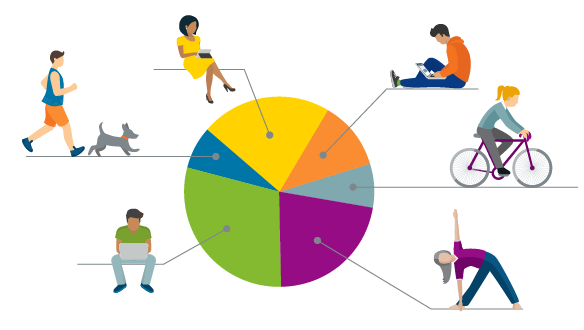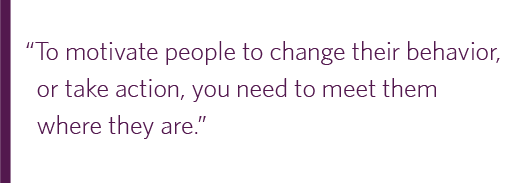
Improve employee benefits engagement through targeted messaging strategies

Pull up any website, open your email, or look at your Facebook feed. How many times have you seen an ad and thought, “Are they reading my mind?” Turns out, they are. Those highly targeted advertisements are not a coincidence. They are built from incredibly sophisticated sets of data that leverage your buying habits, the websites you visit, where you live—even your voting history. Marketers have invested countless resources in understanding how you think, what you’re interested in, and how to get you to click “Buy.”
Consumer marketing is already highly advanced, targeted, and personalized. Employee benefits communication is competing with those sophisticated marketers and their limitless advertising budgets. This means human resources and benefits teams are often left playing catch-up for employees’ attention, with limited resources to deliver a good experience that lives up to employee expectations.
If that weren’t enough, the number of communications that people receive on a daily basis continues to grow. In fact, a study done a few years ago found that we get an average of 63.5 notifications on our phone each day!1 Add that to the number of in-person interruptions we experience every day, and it’s easy to see that we’re now living in a world of information overload. Competition for our limited attention is fierce.
Customizing your benefits communications to your employees
The good news is that employers have brand recognition and access to employees that many consumer brands don’t have. The not-so-good news is that it’s difficult to engage with increasingly diverse employee populations—especially through broad-based general messages.
This is why targeted messages are so successful in benefits communication. Using information about plan enrollment or your employees’ current situation (e.g., marital status, income, etc.) allows you to reach the right person at the right time with the right message. And, knowing how people act and what they prefer can be even more valuable in creating behavior change and driving action.
We are delighted to partner with Kantar Consulting—a leader in market research, data collection, and marketing—to provide this level of insight and segmentation, so our clients can gain a deeper understanding of their employees and make communication targeting even more deliberate.

Blending Kantar's expertise on the data side and two of their core methods, with our expertise on the engagement and communication side, we have developed a rich segmentation offer. By matching employee data with consumer data, employees are organized into 15 unique segments. Each segment contains a complete psychographic profile—demographics, health status, drivers for and barriers to the actions they take, how they use media and technology, their financial health, and many more. This complete picture gives us deeper insight into how to engage employees in their physical, financial, and emotional health, with the right messages at the right time.
The benefits of psychographic targeting
When you target communications on the basis of attitudinal segments (e.g., “Which employees are risk takers?” “Which employees value their health?”), you go a step further than traditional targeting, to answer questions such as:
- How do individuals differ in their attitudes about their own health?
- Who is taking more accountability for their health?
- Who needs help to make changes?
- What should we say to engage them, and how should we say it?
- How can we directly integrate health and wellness insights to address business challenges?
Not surprisingly, information about ourselves captures our attention disproportionately.2 This is even more true when it comes to our health. For example, someone who has trouble finding enough energy to make it through the day isn’t going to be motivated by messages geared toward a group that’s already on top of their health. To motivate people to change their behavior, or take action, you need to meet them where they are. Then, focus on small, easy choices—or “script the critical moves,” as authors Chip and Dan Heath so aptly put it in their New York Times best-selling book, Switch.
You can also use an attitudinal segmentation solution to target communications about topics other than health and wellness. For these, you’d use a more general set of questions than those above:
- Who are our best targets and how do we find them?
- What are the motivations and barriers influencing their decisions?
- How receptive is each segment to marketing, and what are their preferred channels?
- What should we say to engage them, and how should we say it?
- How can we directly integrate consumer attitudinal insights into our own database for more effective targeting and communication?
How it works
Partnering with Kantar Consulting allows us to tap into their ability to match a client's employee data with its database of 260 million U.S. adults. (Kantar uses name and home address only, so no need to worry about handling or transmitting sensitive personal or health information.) We then give our client a report that tells them where their employee population falls in terms of the different attitudinal segments. Clients can use this to focus both their program development and their communication efforts. We, or the client's internal communications team, can also use the information to target communications and create different messages for the different segments.
Employee engagement is an elusive goal for many organizations, but it doesn’t have to be. Employers can deploy the same marketing approach that big brands do, and use data to better understand how to connect with employees. Gaining deeper insights into your employee population—and identifying how to use that data in your communications strategy—can help you improve engagement across all benefits.
We're proud to work with large employers who recognize the business value of engaging employees in benefits. If you want to learn more, contact us.
1 Karen Church, Rodrigo de Oliveira, Martin Pielot. An in-situ study of mobile phone notifications, (MobileHCI’14 Proceedings of the 16th International Conference on Human-computer interaction with mobile device services, 2014).
2 G.W. Humphreys, J. Sui, Attentional control and the self: The Self-Attention Network (SAN), (Cognitive Neuroscience 7: 5–17, 2016).
